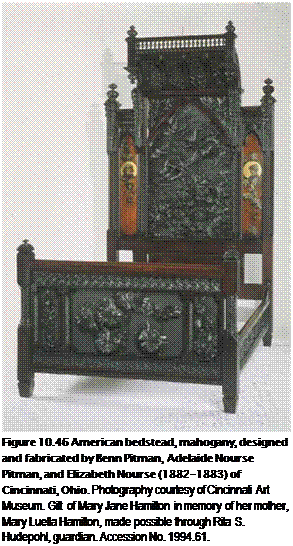The nineteenth century witnessed the rise of architects as furniture designers. Architects had knowledge of both design and furniture fabrication and, in some respects, assumed the previous positions of ebeniste and menuiser. During this period, there was a growing culture of architecture and craft supported by an unprecedented outpouring of publications and treatises on beauty, furniture patterns, and craft. It was during this time that the Arts and Crafts movement began, marking a reaction to the Industrial Revolution and industrial production.
Alarmed by the poor design and quality of furniture products, the minimal use of hand craftsmanship, and the environmental degradation of the Industrial Revolution, the architect Augustus Welby Pugin (1812-1852) wrote his first book, Gothic Furniture in the Style of the Fifteenth Century (1835), which helped shape the Arts and Crafts movement. Much of his furniture was decorated with carving, but the carving did not hide the structure clearly stated in his designs. Pugin was specific about the distinction between structural necessity and applied decoration. He designed furniture in the medieval style, which was notable for its fabrication as well as its decoration.
The writings of Pugin and the teaching of John Ruskin (18191900), author of The Seven Lamps of Architecture (1849) and The Stones of Venice (1851-1853), stressed the importance of structural frankness and fundamental truth in materials. These treatises were reminders to the burgeoning industrial revolutionists that mechanization would not capture the freedom and creative spirit of the craft- sperson. Ruskin is considered to have been the founding father of the English Arts and Crafts movement. He believed in the total rejection of machine-produced products, saying that they were dishonest. He believed that machine-produced goods were inferior to works of skilled craftsmanship and called for a return to the practices of the medieval craft guilds.
Englishman William Morris (1834-1896) was responsible for many improvements to common household objects such as the rush-bottomed Sussex chair, named after a country chair from Sussex, England (Figure 10.45). He and his company (Morris and Co.) hand fabricated traditional country furniture in response to the decline in the quality of contemporary furniture. Though Morris designed and fabricated work ranging from simple to elaborate furniture, his Lesser Arts of Life (1882) pointed out the difference between the necessary work-a-day furniture and the more elaborate "state furniture."
Benn Pitman (1822-1910) taught woodcarving at the Art Academy in Cincinnati, Ohio, and produced an extensive amount of
 unique wood-carved furniture during his long career (Figure 10.46). The success of his work and teaching in the Midwest paralleled the broad appeal of crafted and carved furniture throughout the United States at that time. Hand-worked furnishings became extremely valued during the mid-1800s and the demand fueled an emerging market for crafted works, which, in turn, evolved into the hybridization of craft and design during the late 1800s.
unique wood-carved furniture during his long career (Figure 10.46). The success of his work and teaching in the Midwest paralleled the broad appeal of crafted and carved furniture throughout the United States at that time. Hand-worked furnishings became extremely valued during the mid-1800s and the demand fueled an emerging market for crafted works, which, in turn, evolved into the hybridization of craft and design during the late 1800s.



